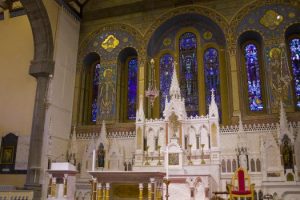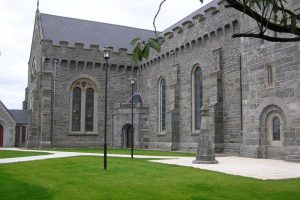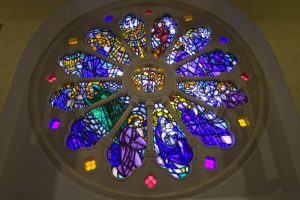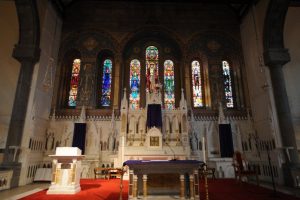| Monday - Friday |
10 a.m. |
| Saturday- |
6.30 p.m. |
| Sunday | 9 a.m. & 12 Noon |
| Funeral Mass |
Celebration of Funeral Mass is at 11 A.M. |
One of the results of Catholic Emancipation was the impressive expansion in church buildings and Kilrush was to prove no different. The local landlord Colonel Moore Vandeleur donated a site for a church in Toler Street together with a gift of five hundred pounds towards its erection. It was in November 1839 that the foundation stone was laid amidst a scene of great enthusiasm with an estimated ten thousand people in attendance.
A chapel committee was formed and began to organise workers for this formidable task. The stone for the building was quarried and carted form Moneypoint
It is estimated that it took about ten months for the main fabric of the building to be completed and an opening day of Sunday the 29th of November 1840 was agreed. Fr. Mathew was invited to preach the first in a series of charity sermons and a Thomas Mahony was ordained as part of the ceremony. It is estimated that three thousand euro was collected on that day toward the cost of the building. Such fundraising ventures continued and it was during the appointment of Fr. Kelly the debt was cleared and further improvements were made. These included the plastering the interior, the erection of a wall and railing outside. He also worked on the interior ceiling, alters, floors and seating. On completion of the seating there was a mission held in the Church for three weeks. The limestone cross near the entrance is to mark this event.
In 1932 Rev. P.J. Canon Hogan PP commissioned from the Harry Clarke Studios in Dublin the three windows on west wall to the rear of the sanctuary. The window on the left wall which depicts St. Brigid and St. Mel at St. Patrick’s Synod is also designed and painted in the Harry Clarke Studios.
It was not until 1861 that he spire of 230 feet in height was erected on the Church in Kilrush. It had the note of being the first Roman Catholic Church in the county with such a feature.
The sanctuary as we know it today was erected in 1881 and the old wooden structure was moved to Monmore Church. This was followed by the provision of a new Organ in 1878. The original organ was worked manually but a new tabular pneumatic system later replaced the old tracker system.
Little changed in the Church until the arrival of Rev. John Dean McInerney in 1906. He under took a full restoration of the church both interior and exterior. He engaged a Mr Ashlin an esteemed ecclesiastical architect who designed the magnificent wooden pulpit and the four wooden confessionals. He also advised two light windows in each transept and in the chancel each side of the stained glass windows and an extension to the priest sacristy to provide for conferences of clergy
While Rev. P.J. Canon Hogan was PP that the mosaic floor in the sanctuary was laid and a central heating system installed. Later renovations were carried out during Canon Peter Ryan. Fr Sheedy contracted Eamon Heddreman as architect and L and M Keating to carry out its most recent and award winning renovation.



